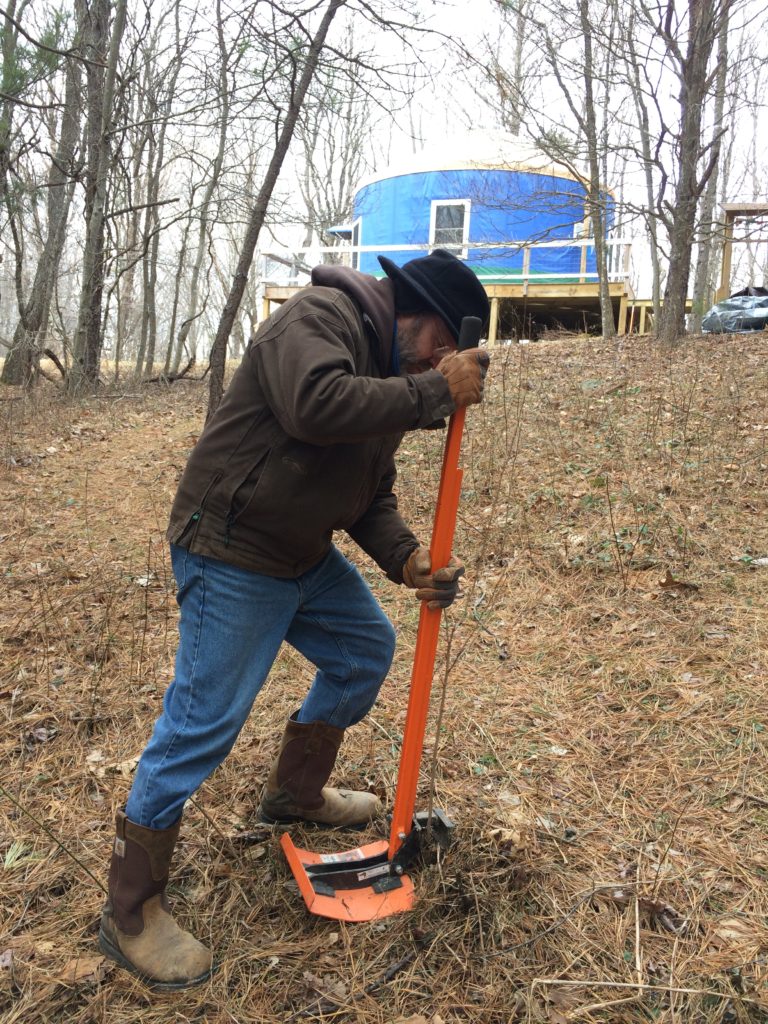Removing unwanted woody plants with the “chop-drop-yank” approach
by Joe Murray
(Note: This post was originally submitted as an article to the Warm Springs Garden Club newsletter – May 2019)
When Anne and I encounter a woody plant that doesn’t “fit” in our landscape, we employ our own unique “chop-drop-yank” approach to remove the botanical interloper. Our most common unwanted woody plants are multiflora rose, autumn olive, Japanese barberry, oriental bittersweet, and assorted briars. We don’t fancy using herbicides (or any products ending in “-cide”) or tractors pulling up plants. We try to move gently on the land to have minimal impact on soil and its interconnections with the “living” landscape.

Anne initiates the process with her shears and loppers, “chopping and dropping” the shoot systems of unwanted woody plants (Figure 2).

The chopping and dropping of woody plants’ shoot systems improves our efficiency by saving time – no need to drag brush to a cart for disposal on a burn pile! Additionally, the cut pieces cover the soil as a rough-and-ready mulch until its decomposition yields organic matter and returns nutrients to the soil. Anne whittles away at the shoot system, leaving approximately 18” of stem above ground which I use later when I follow behind – pulling up the root system of the unwanted woody vegetation with the aid of an extraction device. Using the age-old principle of leverage (Figures 3-5), I place the jaws of the Extractigator on the base of the woody stem, gradually pull back the handle, and watch with satisfaction as the plant’s root system rises out of the ground. I then grasp the upper portion of the stem (that Anne thoughtfully left) and gently tug the remainder of the plant from its terrestrial realm.

Figure 3. Pulling sequence – step 1. Clamping the base of the plant. 
Figure 4. Pulling sequence – step 2. Leaning back to pull the plant up from the earth. 
Figure 5. Pulling sequence – step 3. Extracted plant… roots and all! (Autumn Olive)
Tapping the root several times on the ground knocks off any soil before tossing the extracted root system to the forest floor. There, it starts the slow and gradual process of decomposition along with its chopped bits and pieces of stems. If the plant is too big for the Extractigator, we simply chop-and-drop for two or three consecutive years until the root system has depleted all of its stored energy and presents a dead tombstone-like stump that will eventually decompose.

An internet search reveals many different kinds of plant-pulling tools. Our preference, the Extractigator© employs the leverage produced by our weight (not our strength) leaning on the fulcrum to lift the plant’s roots out of the ground. We purchased two sizes: the “Classic” jaw size is capable of grasping stems up to 2 inches in diameter, while the “Junior” jaw size grasps stems with diameters up to 1.5 inches. The smaller junior model weighs approximately 3 pounds less, much appreciated when spending an afternoon hiking through the woods, popping-up plants. The company also makes other sizes for substantially larger stems, as well as a diminutive version for stems less than one-half inch. Sadly, at this time there are no distributors in Virginia. We ordered our Extractigators directly from the manufacturer in Canada and found the purchase and shipping to be straight forward.
We like our approach to managing unwanted woody plants. We feel this approach gives us the opportunity to interact more closely with all of nature’s interconnections in a particular place on our landscape. In addition to identifying and working on the unwanted plants, we’re noticing (and celebrating) the diversity of other plants, mosses, lichen, rocks and critters that often go unnoticed. We no longer fret about unwanted plants on our property because we know that within two or three years we will have worked our way through all our land. When we return to an area that we addressed several years back, we rejoice (Anne actually dances!) seeing the land hasn’t returned to its unruly, pre-managed state. Rather, these managed areas behave with a different intention. We’ve noticed the native vegetation flexing more muscle and holding its ground, making it even easier on our next visit to chop-drop-yank the few holdout unwanted woody plants that dared return.
If you would like to learn more, visit the company’s website www.extractigator.com
They can also be reach via email at [email protected] or phone at 1-855-743-0353.
